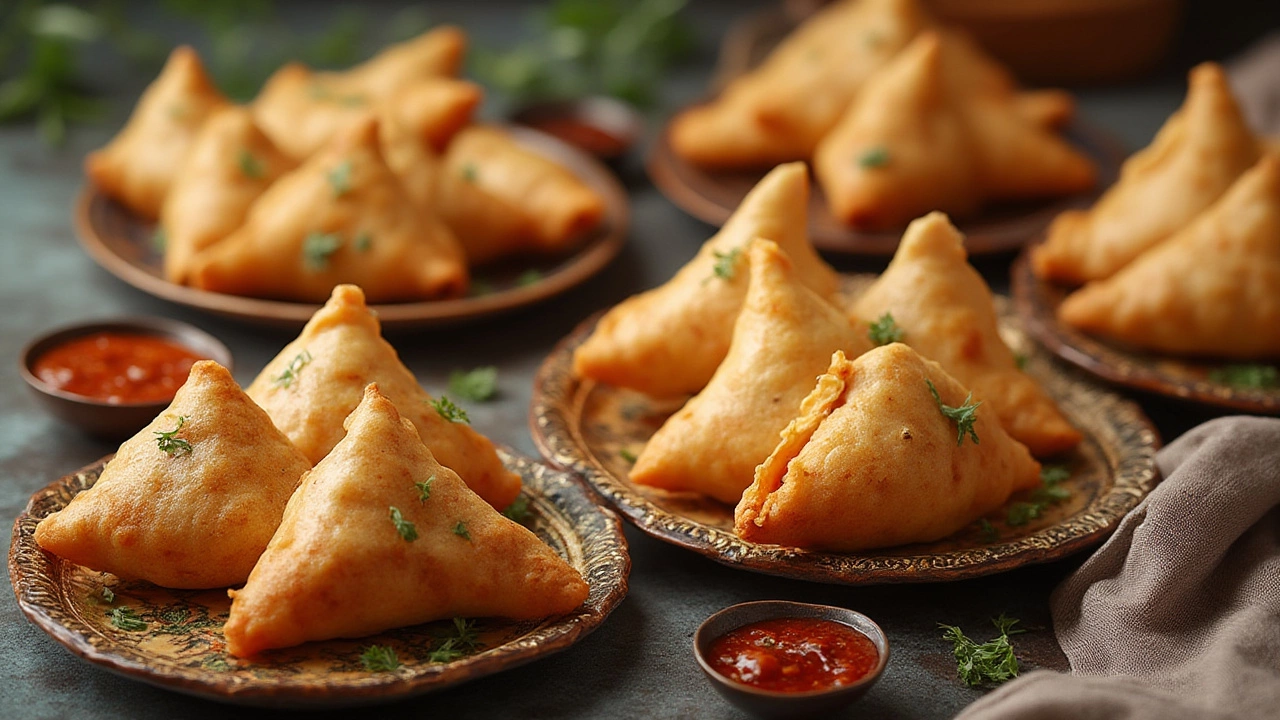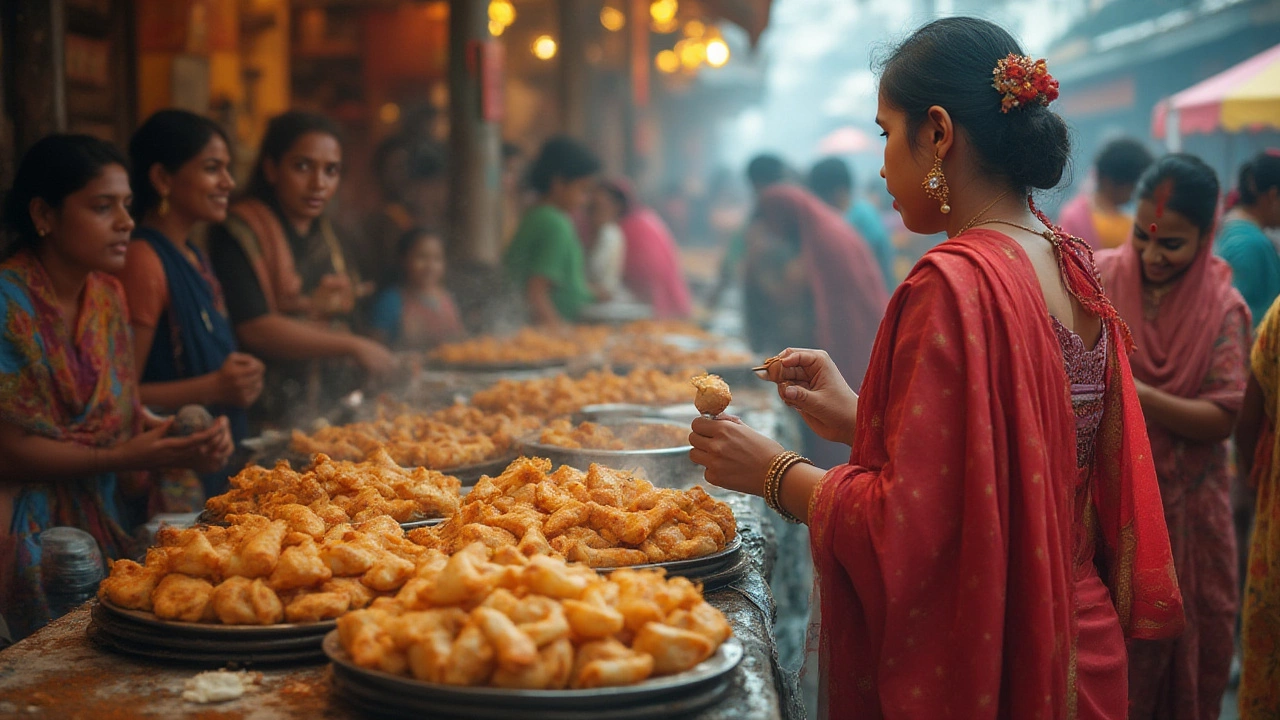Ask anyone to picture a snack that unites a billion people across hundreds of languages, religions, and traditions, and the odds are high that one spiced, triangle-shaped pastry springs to mind — the samosa. Some swear their city’s version is the best, while others have childhood memories of their grandmother’s carefully folded versions sizzling in the frying pan. Samosa isn’t officially crowned India’s national snack — there’s actually no formal decree — but step out on a street in Delhi, Mumbai, Chennai, or Kolkata, and you’ll find that it’s the ultimate culinary equalizer. People grab it on their way to work, savor it during monsoons with steaming chai, and put it on wedding menus. What is it about this humble, hand-sized parcel that has woven itself into the fabric of India’s culture?
The Origins of the Samosa: From Ancient Times to Indian Streets
Long before the samosa became a staple at every Indian chai stall, it began its journey elsewhere. Historians trace its roots to the Middle East, where a stuffed pastry called ‘sambusak’ appeared in Persian texts as early as the 10th century. Traders and travelers carried the flaky, fried stuffed triangles into Central Asia and eventually to the Indian subcontinent, with its earliest record in India popping up around the 13th or 14th century in royal kitchens. Back then, the filling was often minced meat, onions, and spices.
The samosa didn’t stick with its original identity for long. Once it hit Indian soil, local cooks adapted it to suit regional tastes. Potatoes, which arrived from the Americas much later, became the favorite filling — especially after the British introduced spuds during colonial rule. The addition of green peas, spices like cumin and coriander, and sometimes even cashews and raisins, made it uniquely Indian. Eventually, the samosa trickled down to become a street food for the masses. No longer just for royalty, it started popping up at every street corner, railway platform, and school canteen, evolving into the snack loved by millions today.
What’s fascinating is how fast samosas integrated into every region’s food DNA. In Punjab, they’re often larger with a thick, crunchy pastry. In Bengal, shrimp or even sweetened chhena (cottage cheese) might fill the samosa. In the South, you’ll find tiny, cocktail-sized beauties flavored with curry leaves. As trade flourished and migration patterns shifted, the samosa didn’t just remain in India — it tagged along to Africa, the Middle East, and even Britain, morphing into a truly global snack.
Why Samosa? The Symbolism and Popularity of India’s National Snack
The samosa’s biggest magic trick is how it fits every occasion. Grab-and-go snacks are a must-have in India’s fast-moving cities, and few foods balance taste, portability, and affordability like the samosa. Thanks to its triangular pocket, it tucks a punchy, flavorful filling inside a crisp shell, perfect for holding in your hand as you weave through busy markets or wait at a bus stop. The snack crosses class divides; it’s eaten by college students on a strict budget, office workers escaping a dull afternoon, or party guests nibbling before dinner.
Ask people what makes samosas special, and you’ll get a dozen answers. Some love the spud and pea filling spiked with garam masala, while others crave onion or keema (minced meat) versions. Some delight in that first bite, where the crisp gives way to soft, spicy comfort. Samosas are more than just snacks — they’re comfort food, nostalgia, and a cultural equalizer. Monsoon season is almost synonymous with samosas and chai, a pairing so iconic that recipes circulate just to ‘monsoon-proof’ the pastry (making them stay crisp in damp weather).
But is samosa officially India’s national snack? Technically, the answer is no — the government hasn’t declared it as such. But it enjoys such widespread love and recognition that it needs no formal tag. Think of it like the Beatles were never ‘officially’ declared the UK’s greatest band, but who’s going to argue? In a country where opinions diverge on just about everything, samosa is the rare topic few will fight over. It’s the first snack that comes to mind for millions, the one everyone’s grandmother made, and the treat doled out at school when exam results went well.
Here’s a fun tidbit: In a recent survey by a leading Indian food delivery app (Zomato, 2024), samosas topped the list for the most-ordered snack during festivals and cricket matches. Massive volume, too — more than 50 million pieces delivered during last year’s IPL season alone. If numbers are anything to go by, samosas reign supreme.

Samosa Across India: Regional Twists and Types
India is a country where food changes from one neighborhood to the next, and samosas are no exception. The northern-style samosa — large, potato-filled, with peas, served piping hot with tamarind and mint chutney — is the classic version, but there’s no end to the creativity. Each state seems to put its own stamp on the snack.
- Punjabi Samosa: Thick-skinned with a hearty potato and pea stuffing, often flavored with ginger, green chillies, and a touch of amchur (dried mango powder) for tartness.
- Bengali Shingara: Smaller, flakier, sometimes filled with cauliflower, peanuts, or even sweet coconut, making for an intriguingly different taste and texture.
- Mumbai Samosa: Usually smaller, sometimes encased in soft bread rolls (samosa pav) with spicy chutneys, a true street-side fix for anyone in a rush.
- South Indian Samosa: Here, pastry is thinner and sometimes rice-based. The filling can include chopped carrots, curry leaves, or cabbage, all spiced differently from the north.
- Gujarati Singhada: These are often sweet-savory, stuffed with peas, and sometimes even dry fruits, served during festivals like Diwali for a distinct flavor profile.
The variety doesn’t stop at India’s borders either. In Kenya and Tanzania, samosas have become party starters at family gatherings, with spicy minced meat or lentil fillings. In the UK, onion samosas are a standard shelf item in any major supermarket, thanks to the Indian diaspora. Even in Sydney, where I live (and where I rely on Arjun’s discerning snack sense), you’ll spot them at every multicultural food fair.
The biggest trick is adapting the recipe to local ingredients and tastes. For example, in Rajasthan, you’ll find spiced lentils instead of potatoes, reflecting the scarcity of root vegetables in the desert climate. You can spot these subtle tweaks when you travel or visit friends from different regions, and everyone swears their version is the best — which is probably the heart of why the samosa stands out as India’s national snack. There’s no such thing as a single, ‘official’ samosa; instead, there are dozens, and all are fiercely loved.
Nutritional Value and Making the Perfect Samosa at Home
Okay, so we know samosas are irresistible, but are they healthy? Let’s get honest. Traditional samosas are deep-fried — that’s part of the charm — so they’re best enjoyed in moderation. A standard potato-filled northern samosa has around 130-150 calories, depending on size and ingredients. Here’s a quick breakdown (per one medium piece):
| Nutrient | Average Value per Samosa |
|---|---|
| Calories | 140 |
| Carbohydrates | 19g |
| Protein | 3g |
| Fat | 6g |
| Fiber | 2g |
| Sodium | 210mg |
If you’re craving samosas but want a lighter version, try baking them instead of frying. Swap regular flour for whole wheat to add fiber, or fill with mashed peas, carrots, or lentils for a protein boost. Air fryers are a modern-day blessing for fans who want that crunch without a river of oil. The trick is to brush the samosas with a thin layer of oil and keep a close eye so they don’t over-crisp.
Here are some tips for making that perfect samosa at home:
- Use cold water while kneading the dough for an ultra-flaky crust.
- Rest your dough for at least fifteen minutes for easy rolling and folding.
- If you’re a spice fan, add a touch of chili or ginger to your filling for extra kick.
- Seal the edges with a flour-water paste to avoid leaks while frying.
- Cook on medium heat — high heat browns the outside but leaves the inside uncooked, low heat makes things soggy.
Serving samosas is an art. Don’t forget the chutneys! Tangy tamarind and mint-coriander chutney pair perfectly, and a sprinkle of chaat masala before serving ups the flavor even more. In fact, in recent years, chefs in India and beyond have started experimenting — stuffing samosas with everything from cheese and chocolate to Thai curry fillings. There’s even samosa chaat, where broken samosas meet yogurt, chickpeas, onions, and chutneys, creating a riot of flavors and textures in every bite.

The Global Journey: Samosa as a Symbol of India’s Snack Culture
Samosas are one of those rare foods that have travelled the world, adapting and thriving wherever they land — a bit like the Indian diaspora itself. Today, the snack is almost like a passport for Indian street food, found in Irish pubs, Canadian food trucks, and bustling Dubai markets. Bollywood stars snack on them, politicians serve them with tea, and during cricket matches, you’ll spot as many samosas as chirpy fans. The India national snack is part of daily life and special celebrations alike.
When I first moved to Sydney, I found samosas in an Indian grocery a few blocks from my flat. If I’m honest, they tasted different — the pastry was thicker, the spice blend muted. But sitting with Arjun on a rainy Sunday, sharing a plate of samosas and telling family stories, I realized taste isn’t the only thing that matters. The snack brings connection, nostalgia, and a sense of belonging, even thousands of kilometers from home.
Modern Indian chefs are running wild with the samosa template: think pizza toppings inside, butter chicken samosas at posh restaurants, or sweet takes like chocolate and banana. Some shops in Delhi even offer ‘samosa flights,’ where you sample several flavors in one go. That kind of creativity keeps the snack relevant, trendy, and loved by young and old. People post samosa selfies, review the best samosa joints on Instagram, and foodie blogs constantly debate which city does it best.
So, while India may not have a formal ‘national snack’ on the books, just walk through any Indian town at four in the afternoon, and listen for the sizzle behind a chai stall. That’s the soundtrack of a nation united by its love for a simple, spicy, crunchy pastry — the samosa, forever and always the real star of India’s snack stage.
